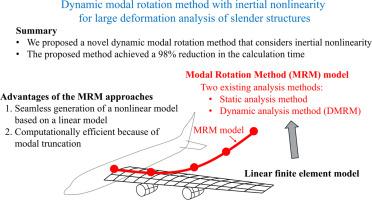含惯性非线性的细长结构大变形分析的动态模态旋转法
IF 4.9
2区 工程技术
Q1 ACOUSTICS
引用次数: 0
摘要
由于高展弦比机翼可以抑制诱导阻力,因此可以用于下一代飞机,如高空长航时(HALE)飞机。高保真模型,如非线性壳/板或实体有限元模型,用于分析具有多自由度的大动态变形,计算量很大。模态旋转法(MRM)是一种基于从任何线性或线性化模型中获得的模态和刚度矩阵有效分析大变形的静态分析方法。MRM以小应变、大位移的细长结构为目标,考虑几何非线性而非材料非线性。动态MRM (Dynamic MRM, DMRM)是将MRM扩展为一种动态分析方法而发展起来的,它能够有效地利用模态方法进行非线性动态分析。然而,传统的DMRM是在可以忽略惯性非线性的假设下制定的。本文提出了一种考虑惯性非线性的DMRM方法。为了实现这一点,重点放在MRM和刚体多体系统之间的相似性上。此外,该方法还在运动方程中加入了阻尼项。这使得所提出的方法的分析结果与阻尼效应的实验结果之间的比较。该方法可以考虑模拟中的惯性非线性,与非线性板有限元法相比,计算时间缩短了98%。此外,对于大变形梁,该方法与实验结果吻合较好。本文章由计算机程序翻译,如有差异,请以英文原文为准。

Dynamic modal rotation method with inertial nonlinearity for large deformation analysis of slender structures
As high-aspect-ratio wings can suppress induced drag, they are used for next-generation aircraft such as high-altitude long-endurance (HALE) aircraft. High-fidelity models such as nonlinear shell/plate or solid finite element models, which analyze large dynamic deformations with many degrees of freedom, are computationally intensive. The modal rotation method (MRM) is a static analysis method that efficiently analyzes large deformations based on modes and stiffness matrices obtained from any linear or linearized model. MRM targets slender structures with small strains and large displacements and considers geometrical nonlinearity rather than material nonlinearity. Dynamic MRM (DMRM), which was developed by extending the MRM to a dynamic analysis method, can efficiently perform nonlinear dynamic analyses using a modal approach. However, the conventional DMRM was formulated under the assumption that the inertial nonlinearity can be neglected. In this study, a novel DMRM that takes inertial nonlinearity into account was proposed. To achieve this, emphasis was placed on the similarities between MRM and rigid multibody systems. In addition, a damping term has been included in the equation of motion in the proposed method. This enables a comparison between the analytical results of the proposed method and the experimental results with damping effects. The proposed method can account for the inertial nonlinearity in a simulation performed and reduce the calculation time by 98% compared to the nonlinear plate finite element method. Moreover, the proposed method with damping showed good agreement with the experimental results for large beam deformations.
求助全文
通过发布文献求助,成功后即可免费获取论文全文。
去求助
来源期刊

Journal of Sound and Vibration
工程技术-工程:机械
CiteScore
9.10
自引率
10.60%
发文量
551
审稿时长
69 days
期刊介绍:
The Journal of Sound and Vibration (JSV) is an independent journal devoted to the prompt publication of original papers, both theoretical and experimental, that provide new information on any aspect of sound or vibration. There is an emphasis on fundamental work that has potential for practical application.
JSV was founded and operates on the premise that the subject of sound and vibration requires a journal that publishes papers of a high technical standard across the various subdisciplines, thus facilitating awareness of techniques and discoveries in one area that may be applicable in others.
 求助内容:
求助内容: 应助结果提醒方式:
应助结果提醒方式:


